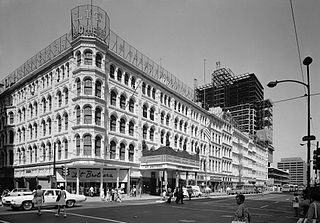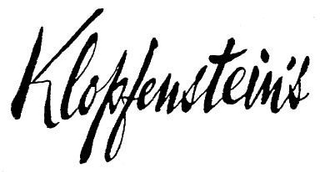Related Research Articles

Tysons Corner Center, located in the Tysons unincorporated area in Fairfax County, Virginia, United States, opened to the public in 1968, becoming one of the first fully enclosed, climate-controlled shopping malls in the Washington metropolitan area.
Woodward & Lothrop was a department store chain headquartered in Washington, D.C. Woodward & Lothrop was the capital's first department store, opening in 1887. Woodies, as it was often nicknamed, maintained stores in the Mid-Atlantic United States. Its flagship store was a fixture of the shopping district in downtown Washington, with Garfinckel's, and in the late 1990s the center of controversy over competing visions for DC's urban renewal.

Penn Quarter is a neighborhood in the East End of Downtown Washington, D.C. north of Pennsylvania Avenue NW. Its boundaries are not well established, but they appear to extend along Pennsylvania Avenue NW from 5th to 10th Streets, and approximately H Street NW on the north where Penn Quarter abuts or partially overlaps with Chinatown. Penn Quarter is southeast of the Metro Center shopping district. Penn Quarter has been rejuvenated over the past several decades, stimulated first by the Pennsylvania Avenue Development Corporation (PADC) and later, following the recession in the 1990s, by the Capital One Arena, a sports, concert and event arena that opened nearby at 7th and F streets in 1997 as the MCI Center and was later called the Verizon Center. Penn Quarter now boasts a variety of entertainment and commercial establishments including museums, theaters, restaurants, bars, and contemporary art galleries. The area is also home to a popular farmers market and several food, wine, art, and culture focused festivals.
The Hechinger Company was an American chain of home-improvement centers headquartered in Landover, Maryland, on the immediate outskirts of Washington, D.C., from 1911 to 1999. It was also an online retailer owned by Home Decor Products from 2004 to 2009.
Shoppers Food & Pharmacy, also known as Shoppers Food Warehouse, is a chain of 25 supermarkets located in the Baltimore and Washington, D.C., metropolitan areas. Shoppers has fresh produce, Swift Angus beef, Smithfield natural pork, all-natural chicken, Dietz & Watson delis, fresh seafood, steamed shrimp, as well as hot foods, and full-service pharmacies.
The Mall at Prince Georges is an enclosed regional shopping mall located in Hyattsville, Maryland, at the intersection of Belcrest Road and East-West Highway. It is served by a Washington Metro station, Prince George's Plaza, which shares the mall's former name. This station is on the Green Line. Located across Belcrest Road from the Mall is the University Town Center mixed-use development. It is currently owned and managed by PREIT.

Sidney Harman Hall is a theater at Sixth and F Streets NW in Washington, D.C. It is part of the Harman Center for the Arts, along with the Lansburgh Theatre. It is the home of the Shakespeare Theatre Company (STC).
Garfinckel's was a prominent department store chain based in Washington, D.C. that catered to a clientele of wealthy consumers. It filed for Chapter 11 bankruptcy in June 1990 and ceased operations that year.
Best & Co. is a luxury jewelry company based in Aspen, Colorado. Founded by 4th generation jeweler Bush Helzberg, Best & Co. creates and sells a curated selection of luxury jewelry.

Lit Brothers was a moderately-priced department store based in Philadelphia. Samuel and Jacob Lit opened the first store at North 8th and Market Streets in 1891. Lits positioned itself well as a more affordable alternate to its upscale competitors Strawbridge and Clothier, John Wanamaker, and Gimbels. The store's slogan was "A Great Store in A Great City," and it was noted for its millinery department.
Lansburgh's was a chain of department stores located in the Washington, D.C. area. The clientele were lower- to middle-income consumers.
Hart Schaffner Marx, founded in 1887 and incorporated in 1911 as Hart Schaffner & Marx, is an American manufacturer of tailored menswear. It is owned by the New York-based Authentic Brands Group. Hart Schaffner Marx is located in Chicago.
The Frank R. Jelleff Co., or more commonly Jelleff's was a Washington, D.C.-based retailer that specialized in women's apparel.

The Village at Shirlington opened as Shirlington Shopping Center in 1944, and was the first large shopping center to open in the Washington, D.C. suburbs and one of the earliest in the United States. It is located along Campbell Avenue at the intersection of Shirley Highway and Quaker Lane / Shirlington Road in Arlington, Virginia. The center has been known since the mid-1980s as The Village at Shirlington.

S. Kann Sons Co., or more commonly Kann's was a department store based in Washington, D.C.. It was the District's second department store and pioneered the one-price policy and "the customer is always right" concept in retailing on the Washington, D.C. retail scene. The stores allowed consumers to return goods for cash.

B. Kuppenheimer & Co., or simply Kuppenheimer, was a men's clothing manufacturing and retail operation based in Chicago, Illinois and later Atlanta, Georgia.

The Shops at National Place was a three-level, indoor shopping mall located in downtown Washington, D.C. in the 16-story National Place Building. It is located on the block bounded by Pennsylvania Avenue, F Street, between 13th and 14th Streets NW, the former site of the Munsey Trust Building. It was located near the Metro Center station of the Washington Metro system.
Joseph R. Harris Co. was a Washington, D.C.-based chain of women's apparel stores.

Klopfenstein's was an upscale men's clothing store in the Seattle-Tacoma Metropolitan Area founded in 1918 in Tacoma, Washington. Stores were operated in most of the area's major shopping malls as well as stores in downtown Tacoma and Seattle, across the street from Frederick & Nelson's flagship store. It was owned by Hartmarx from the late 1960s until its closing in 1992.
Dash's Designer, more commonly called Dash's, was an off-price, high-end men's clothing store chain based in Washington, D.C., Georgetown, Maryland and Tysons Corner, Virginia.
References
- ↑ "The Raleigh Haberdasher," The Washington Post Feb 16, 1911, pg. 11.
- ↑ "Raleigh President Sidney Lansburgh Dies at Age 67," The Washington Post, Nov 15, 1983, p. E6.
- ↑ "Closing a Retail Gap: Who Will Ride In to Pick Up Raleighs' Reins?" by Mark Potts and David Hilzenrath, The Washington Post, p. 1.
- ↑ "The Downfall Of a Washington Institution," by Mark Potts, The Washington Post, Jun 22, 1990, p. F1.
- ↑ "Raleigh's to Close F St. Store," by Merrill Brown, The Washington Post, Jan 1, 1980, p. D10.
- ↑ "Raleighs Sells Flagship Store for $7.5 Million," by Paul Thiel, The Washington Post, p. D1.